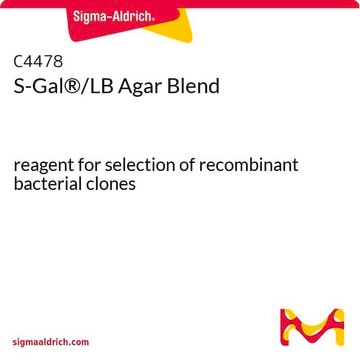S9811
S-Gal®
reagent for selection of recombinant bacterial clones
Sinonimo/i:
3,4-Cyclohexenoesculetin β-D-galactopyranoside
About This Item
Prodotti consigliati
Grado
for molecular biology
Sterilità
non-sterile
Saggio
≥95% (HPLC)
Forma fisica
powder
Solubilità
DMF: 50 mg/mL
Compatibilità
suitable for β-galactosidase test
Temperatura di conservazione
room temp
Stringa SMILE
OC[C@H]1O[C@@H](Oc2cc3OC(=O)C4=C(CCCC4)c3cc2O)[C@H](O)[C@@H](O)[C@H]1O
InChI
1S/C19H22O9/c20-7-14-15(22)16(23)17(24)19(28-14)27-13-6-12-10(5-11(13)21)8-3-1-2-4-9(8)18(25)26-12/h5-6,14-17,19-24H,1-4,7H2/t14-,15+,16+,17-,19-/m1/s1
HDJJDRXZHJRVGA-DIKXUDHVSA-N
Descrizione generale
Applicazioni
Caratteristiche e vantaggi
- More intense color contrast than X-gal
- Excellent for use in automated colony counters
- Autoclavable for easiest use
- No need to make stock solutions
Altre note
formulation. A medium prepared with S-Gal® is moderately dark due to the presence of ferric ammonium citrate. This darker background often provides enhanced contrast for automated colony counting or isolation.
Principio
Ricostituzione
Note legali
Prodotti correlati
Avvertenze
Warning
Indicazioni di pericolo
Consigli di prudenza
Classi di pericolo
Eye Irrit. 2 - Skin Irrit. 2 - STOT SE 3
Organi bersaglio
Respiratory system
Codice della classe di stoccaggio
11 - Combustible Solids
Classe di pericolosità dell'acqua (WGK)
WGK 3
Punto d’infiammabilità (°F)
Not applicable
Punto d’infiammabilità (°C)
Not applicable
Dispositivi di protezione individuale
dust mask type N95 (US), Eyeshields, Gloves
Certificati d'analisi (COA)
Cerca il Certificati d'analisi (COA) digitando il numero di lotto/batch corrispondente. I numeri di lotto o di batch sono stampati sull'etichetta dei prodotti dopo la parola ‘Lotto’ o ‘Batch’.
Possiedi già questo prodotto?
I documenti relativi ai prodotti acquistati recentemente sono disponibili nell’Archivio dei documenti.
Articoli
General protocols for growth of competent cells and their transformation (uptake of DNA).
Protocolli
Technical Article on competent cells. Transformation is a process by which some bacteria take up foreign genetic material (naked DNA) from the environment.
Il team dei nostri ricercatori vanta grande esperienza in tutte le aree della ricerca quali Life Science, scienza dei materiali, sintesi chimica, cromatografia, discipline analitiche, ecc..
Contatta l'Assistenza Tecnica.







